MERCEDES-BENZ C-CLASS ESTATE 2007 Manual PDF
Manufacturer: MERCEDES-BENZ, Model Year: 2007, Model line: C-CLASS ESTATE, Model: MERCEDES-BENZ C-CLASS ESTATE 2007Pages: 377, PDF Size: 6.19 MB
Page 71 of 377
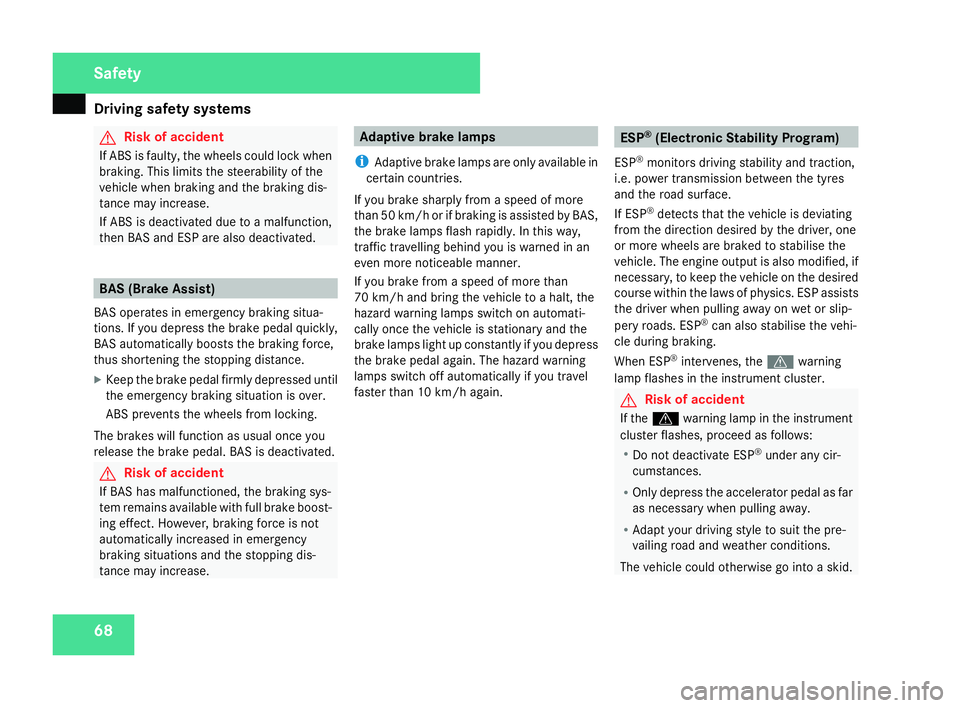
Driving safety sys
tems68 G
Risk of accident
If ABS is faulty, the wheels could lock when
braking. This limits the steerability of the
vehicle when braking and the braking dis-
tance may increase.
If ABS is deactivated due to a malfunction,
then BAS and ESP are also deactivated. BAS (Brake Assist)
BAS operates in emergency braking situa-
tions. If you depress the brake pedal quickly,
BAS automatically boosts the braking force ,
thus shortening the stopping distance.
X Keep the brake pedal firmly depressed until
the emergency braking situation is over.
ABS prevents the wheels from locking.
The brakes will function as usual once you
release the brake pedal. BAS is deactivated. G
Risk of accident
If BAS has malfunctioned, the braking sys-
tem remains available with full brake boost-
ing effect. However, braking force is not
automatically increased in emergency
braking situations and the stopping dis-
tance may increase. Adaptive brake lamps
i Adaptive brake lamps are only available in
certain countries.
If you brake sharply from a speed of mor e
than 50 km/h or if braking is assisted by BAS,
the brake lamps flash rapidly. In this way,
traffic travelling behind you is warned in an
even more noticeable manner .
If you brake from a speed of more than
70 km/h and bring the vehicle to a halt, the
hazard warning lamps switch on automati-
cally once the vehicle is stationary and the
brake lamps light up constantly if you depres s
the brake pedal again. The hazard warning
lamps switch off automatically if you travel
faster than 10 km/h again. ES
P®
(Electronic Stability Program)
ES P®
monitors driving stability and traction,
i.e. power transmission between the tyres
and the road surface.
If ESP ®
detects that the vehicle is deviatin g
from the direction desired by the driver, one
or more wheels are braked to stabilise the
vehicle. The engine output is also modified, if
necessary, to keep the vehicle on the desired
course within the laws of physics. ESP assists
the driver when pulling away on wet or slip-
pery roads. ESP ®
can also stabilise the vehi-
cle during braking.
When ESP ®
intervenes, the vwarning
lamp flashes in the instrument cluster. G
Risk of accident
If the v warning lamp in the instrumen t
cluster flashes, proceed as follows:
R Do not deactivate ESP ®
under any cir -
cumstances .
R Only depress the accelerator pedal as far
as necessary when pulling away.
R Adapt your driving style to suit the pre -
vailing road and weather conditions.
The vehicle could otherwise go into a skid. Safety
204_AKB; 2; 3, en-GB
mkalafa,
2007-06-26T23:11:51+02:00 - Seite 68
Page 72 of 377
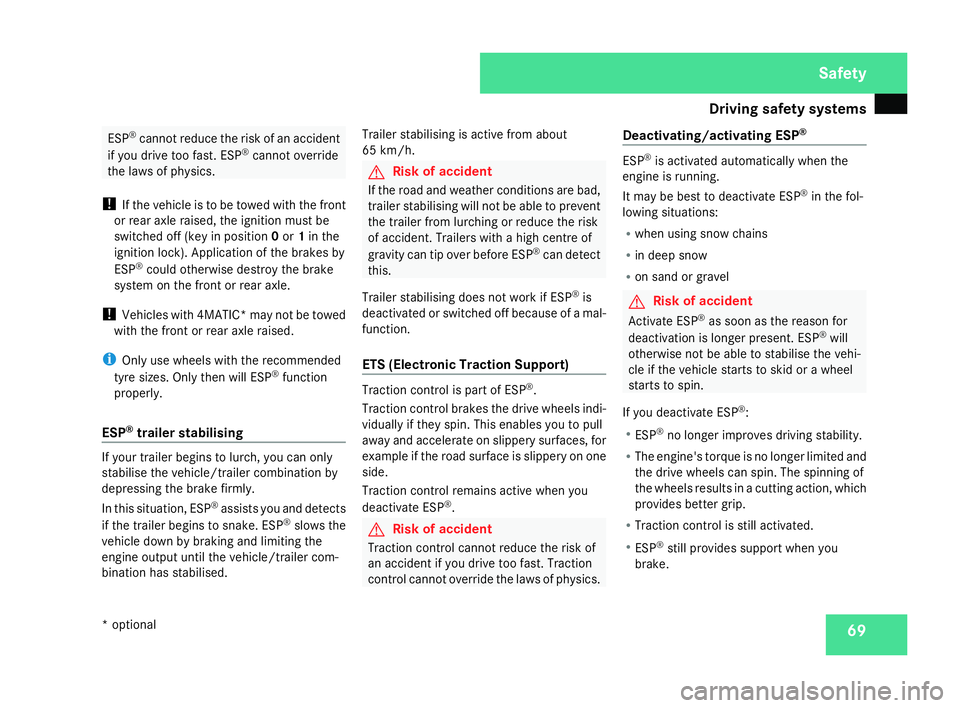
Driving safety sys
tems 69ESP
®
cannot reduce the risk of an accident
if you drive too fast. ESP ®
cannot overrid e
the laws of physics .
! If the vehicle is to be towed with the front
or rear axle raised, the ignition must be
switched off (key in position 0or 1in the
ignition lock). Application of the brakes by
ESP ®
could otherwise destroy the brake
system on the front or rear axle.
! Vehicles with 4MATIC* may not be towe d
with the front or rear axle raised .
i Only use wheels with the recommended
tyre sizes. Only then will ESP ®
function
properly .
ESP ®
trailer stabilisin g If your trailer begins to lurch, you can only
stabilise the vehicle/trailer combination by
depressing the brake firmly .
In this situation, ESP ®
assists you and detect s
if the trailer begins to snake. ES P®
slows the
vehicle down by braking and limiting the
engine output until the vehicle/trailer com-
bination has stabilised. Trailer stabilising is active from about
65 km/h. G
Risk of accident
If the road and weather conditions are bad,
trailer stabilising will not be able to prevent
the trailer from lurching or reduce the ris k
of accident. Trailers with a high centre of
gravity can tip over before ESP ®
can detect
this .
Trailer stabilising does not work if ESP ®
is
deactivated or switched off because of a mal-
function .
ETS (Electronic Traction Support) Traction control is part of ES
P®
.
Traction control brakes the drive wheels indi-
vidually if they spin. This enables you to pull
away and accelerate on slippery surfaces, for
example if the road surface is slippery on one
side.
Traction control remains active when you
deactivate ESP ®
. G
Risk of accident
Traction control cannot reduce the risk of
an accident if you drive too fast. Traction
control cannot override the laws of physics .Deactivating/activating ESP
® ESP
®
is activated automatically when the
engine is running.
It may be best to deactivate ES P®
in the fol-
lowing situations:
R when using snow chain s
R in deep sno w
R on sand or gravel G
Risk of accident
Activate ESP ®
as soon as the reason for
deactivation is longer present. ES P®
will
otherwise not be able to stabilise the vehi -
cle if the vehicle starts to skid or a wheel
starts to spin.
If you deactivate ESP ®
:
R ESP ®
no longer improves driving stability.
R The engine's torque is no longer limited and
the drive wheels can spin. The spinning of
the wheels results in a cutting action, which
provides better grip.
R Traction control is still activated.
R ESP ®
still provides support when you
brake. Safety
* optional
204_AKB; 2; 3, en-GB
mkalafa,
2007-06-26T23:11:51+02:00 - Seite 69
Page 73 of 377
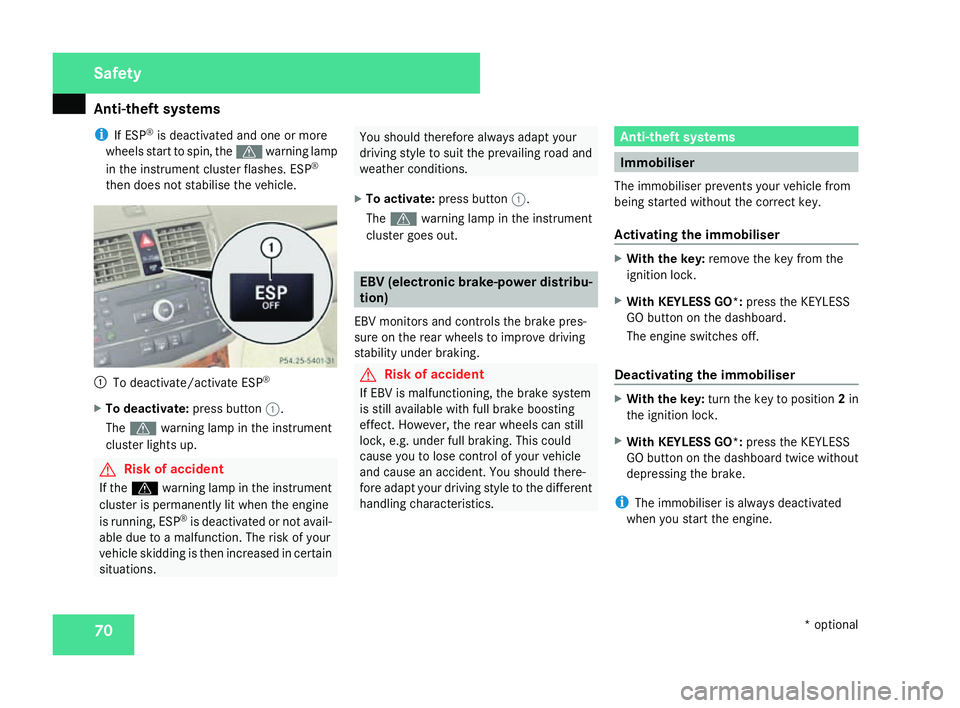
Anti-theft syste
ms70
i
If ESP ®
is deactivated and one or mor e
wheels start to spin, the vwarning lamp
in the instrument cluster flashes. ES P®
then does not stabilise the vehicle. 1
To deactivate/activate ESP ®
X To deactivate :press button 1.
The v warning lamp in the instrumen t
cluster lights up . G
Risk of accident
If the v warning lamp in the instrumen t
cluster is permanently lit when the engine
is running, ESP ®
is deactivated or not avail-
able due to a malfunction. The risk of your
vehicle skidding is then increased in certain
situations. You should therefore always adapt your
driving style to suit the prevailing road and
weather conditions.
X To activate :press button 1.
The v warning lamp in the instrumen t
cluster goes out. EBV (electronic brake-power distribu-
tion)
EBV monitors and controls the brake pres-
sure on the rear wheels to improve driving
stability under braking. G
Risk of accident
If EBV is malfunctioning, the brake system
is still available with full brake boosting
effect. However, the rear wheels can stil l
lock, e.g. under full braking. This could
cause you to lose control of your vehicle
and cause an accident. You should there-
fore adapt your driving style to the differen t
handling characteristics. Anti-theft systems
Immobiliser
The immobiliser prevents your vehicle from
being started without the correct key.
Activating the immobiliser X
With the key: remove the key from the
ignition lock.
X With KEYLESS GO*: press the KEYLESS
GO button on the dashboard.
The engine switches off.
Deactivating the immobiliser X
With the key: turn the key to position 2in
the ignition lock .
X With KEYLESS GO*: press the KEYLESS
GO button on the dashboard twice without
depressing the brake.
i The immobiliser is always deactivated
when you start the engine. Safety
* optional
204_AKB; 2; 3, en-GB
mkalafa,
2007-06-26T23:11:51+02:00 - Seite 70
Page 74 of 377
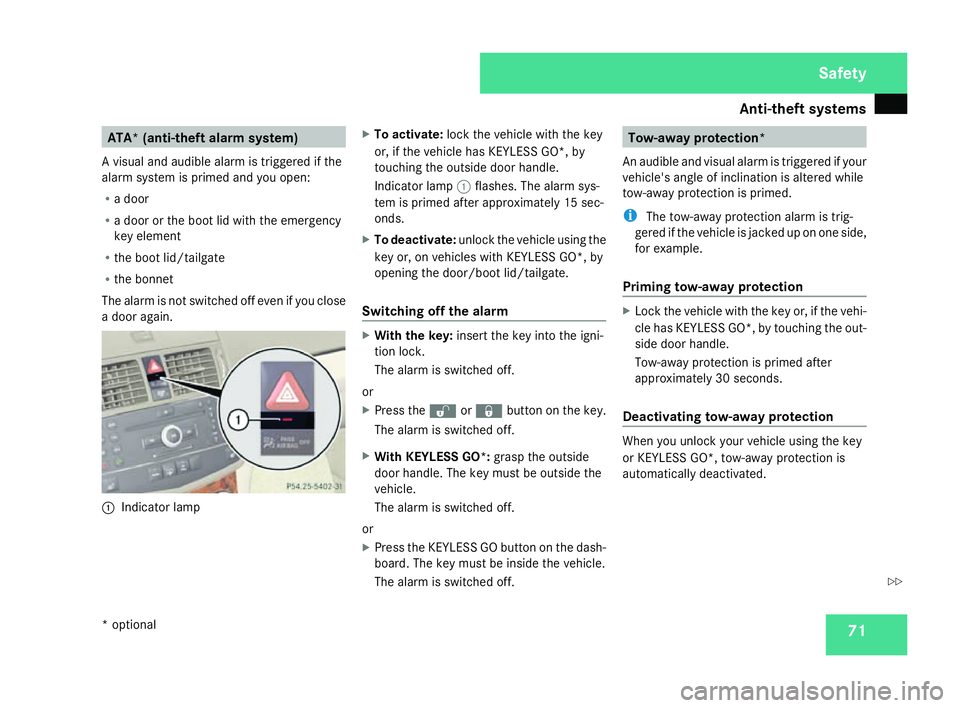
Anti-theft syste
ms 71ATA* (anti-theft alarm system)
A visual and audible alarm is triggered if the
alarm system is primed and you open:
R a door
R a door or the boot lid with the emergenc y
key element
R the boot lid/tailgate
R the bonnet
The alarm is not switched off even if you close
a door again. 1
Indicator lamp X
To activate :lock the vehicle with the key
or, if the vehicle has KEYLESS GO*, by
touching the outside door handle .
Indicator lamp 1flashes. The alarm sys -
tem is primed after approximately 15 sec-
onds.
X To deactivate :unlock the vehicle using th e
key or, on vehicles with KEYLESS GO*, by
opening the door/boot lid/tailgate.
Switching off the alarm X
With the key: insert the key into the igni-
tion lock.
The alarm is switched off.
or
X Press the Œor‹ button on the key.
The alarm is switched off.
X With KEYLESS GO*: grasp the outside
door handle. The key must be outside the
vehicle.
The alarm is switched off.
or
X Press the KEYLESS GO button on the dash-
board. The key must be inside the vehicle.
The alarm is switched off. Tow-away protection*
An audible and visual alarm is triggered if your
vehicle's angle of inclination is altered while
tow-away protection is primed.
i The tow-away protection alarm is trig-
gered if the vehicle is jacked up on one side,
for example.
Priming tow-away protection X
Lock the vehicle with the key or, if the vehi-
cle has KEYLESS GO*, by touching the out-
side door handle .
Tow-away protection is primed after
approximately 30 seconds .
Deactivating tow-away protection When you unlock your vehicle using the ke
y
or KEYLESS GO*, tow-away protection is
automatically deactivated. Safety
* optional
204_AKB; 2; 3, en-GB
mkalafa,
2007-06-26T23:11:51+02:00 - Seite 71 Z
Page 75 of 377
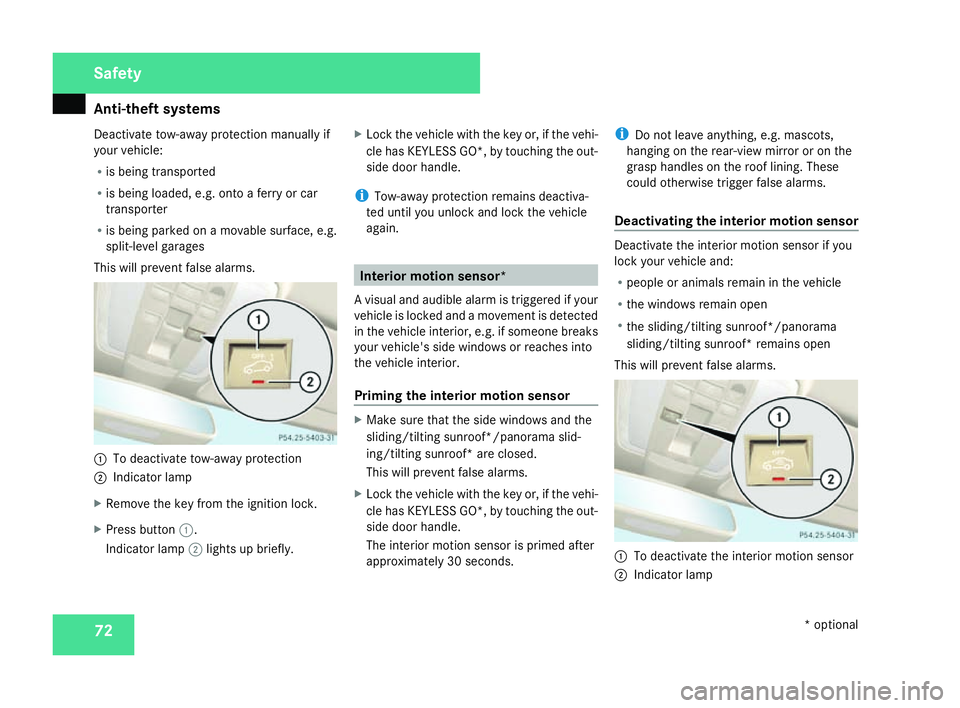
Anti-theft syste
ms72
Deactivate tow-away protection manually if
your vehicle:
R is being transported
R is being loaded, e.g. onto a ferry or car
transporter
R is being parked on a movable surface, e.g.
split-level garages
This will prevent false alarms. 1
To deactivate tow-away protection
2 Indicator lamp
X Remove the key from the ignition lock.
X Press button 1.
Indicator lamp 2lights up briefly. X
Lock the vehicle with the key or, if the vehi-
cle has KEYLESS GO*, by touching the out-
side door handle .
i Tow-away protection remains deactiva-
ted until you unlock and lock the vehicle
again. Interior motion sensor*
A visual and audible alarm is triggered if your
vehicle is locked and a movement is detected
in the vehicle interior, e.g. if someone breaks
your vehicle's side windows or reaches into
the vehicle interior.
Priming the interior motion sensor X
Make sure that the side windows and the
sliding/tilting sunroof*/panorama slid-
ing/tilting sunroof* are closed.
This will prevent false alarms.
X Lock the vehicle with the key or, if the vehi-
cle has KEYLESS GO*, by touching the out-
side door handle .
The interior motion sensor is primed after
approximately 30 seconds. i
Do not leave anything, e.g. mascots,
hanging on the rear-view mirror or on the
grasp handles on the roof lining. Thes e
could otherwise trigger false alarms.
Deactivating the interior motion senso r Deactivate the interior motion sensor if yo
u
lock your vehicle and:
R people or animals remain in the vehicle
R the windows remain open
R the sliding/tilting sunroof*/panorama
sliding/tilting sunroof* remains open
This will prevent false alarms. 1
To deactivate the interior motion sensor
2 Indicator lamp Safety
* optional
204_AKB; 2; 3, en-GB
mkalafa
, 2007-06-26T23:11:51+02:00 - Seite 72
Page 76 of 377
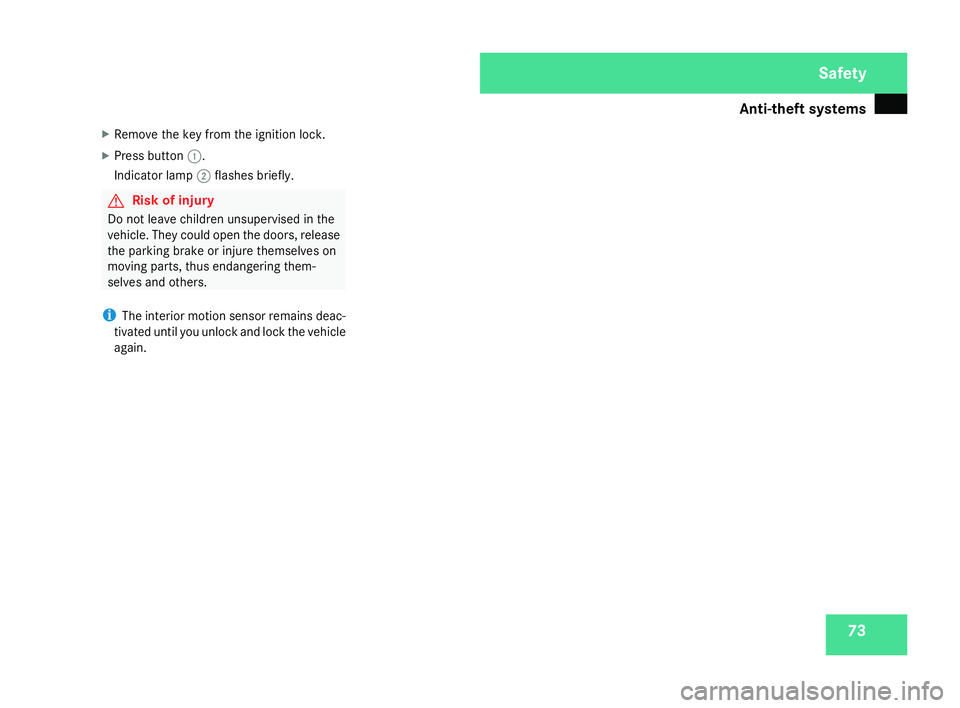
Anti-theft syste
ms 73
X
Remove the key from the ignition lock.
X Press button 1.
Indicator lamp 2flashes briefly . G
Risk of injury
Do not leave children unsupervised in the
vehicle. They could open the doors, release
the parking brake or injure themselves on
moving parts, thus endangering them-
selves and others.
i The interior motion sensor remains deac-
tivated until you unlock and lock the vehicle
again. Safety
204_AKB; 2; 3, en-GB
mkalafa,
2007-06-26T23:11:51+02:00 - Seite 73
Page 77 of 377

74204_AKB; 2; 3, en-GB
mkalafa,
2007-06-26T23:11:51+02:00 - Seite 74
Page 78 of 377
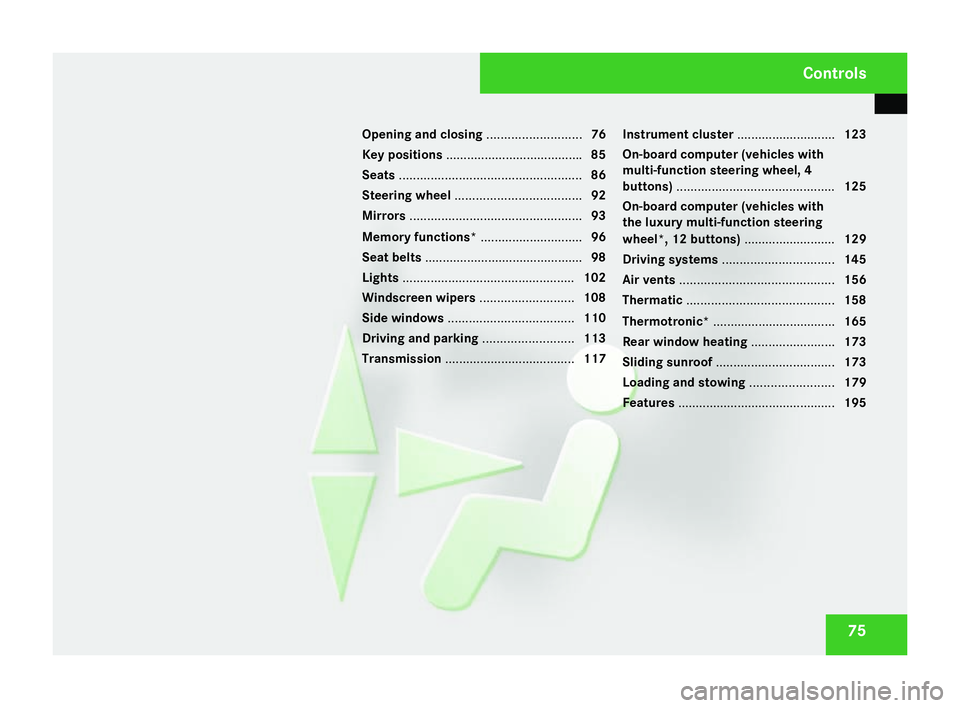
75
Opening and closing
...........................76
Key positions ...................................... .85
Seats .................................................... 86
Steering wheel .................................... 92
Mirrors ................................................. 93
Memory functions* .............................96
Seat belts ............................................ .98
Lights ................................................. 102
Windscreen wipers ...........................108
Side windows .................................... 110
Driving and parking ..........................113
Transmission ..................................... 117Instrument cluster
............................123
On-board computer (vehicles with
multi-function steering wheel, 4
buttons) ............................................. 125
On-board computer (vehicles with
the luxury multi-function steering
wheel*, 12 buttons) ..........................129
Driving systems ................................ 145
Air vents ............................................ 156
Thermatic .......................................... 158
Thermotronic* ................................... 165
Rear window heating ........................173
Sliding sunroof .................................. 173
Loading and stowing ........................179
Features ............................................. 195 Controls
204_AKB; 2; 3, en-GB
mkalafa,
2007-06-26T23:11:51+02:00 - Seite 75
Page 79 of 377
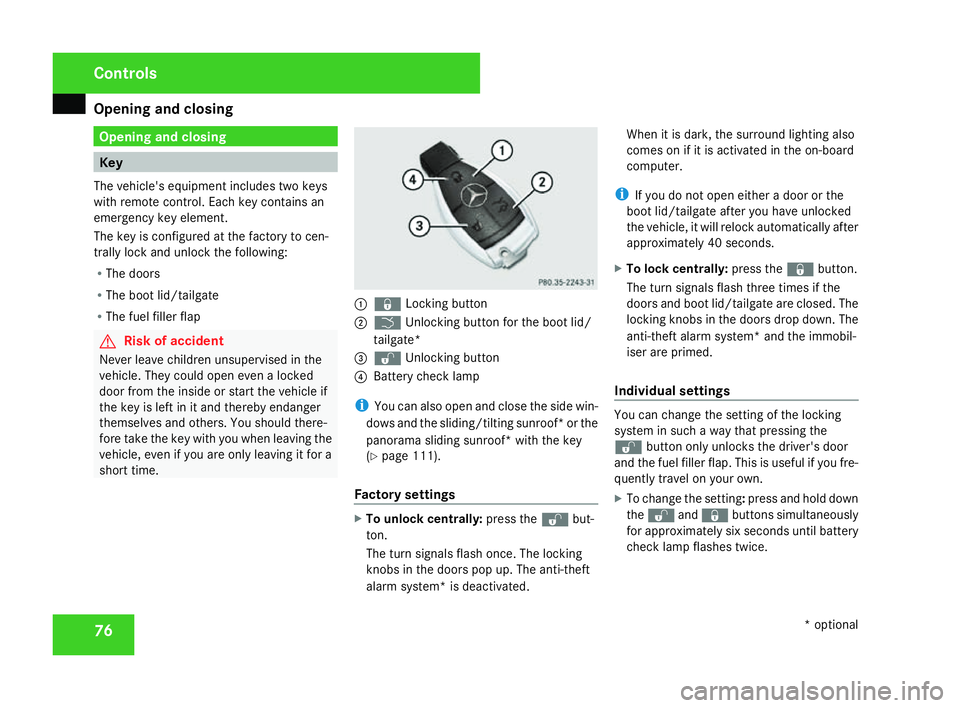
Opening and closing
76 Opening and closing
Key
The vehicle's equipment includes two keys
with remote control. Each key contains an
emergency key element .
The key is configured at the factory to cen-
trally lock and unlock the following:
R The doors
R The boot lid/tailgate
R The fuel filler flap G
Risk of accident
Never leave children unsupervised in the
vehicle. They could open even a locked
door from the inside or start the vehicle if
the key is left in it and thereby endanger
themselves and others. You should there -
fore take the key with you when leaving the
vehicle, even if you are only leaving it for a
short time. 1
j Locking button
2 i Unlocking button for the boot lid/
tailgate*
3 k Unlocking button
4 Battery check lamp
i You can also open and close the side win-
dows and the sliding/tilting sunroof* or the
panorama sliding sunroof* with the key
( Y page 111).
Factory settings X
To unlock centrally :press the kbut-
ton .
The turn signals flash once. The lockin g
knobs in the doors pop up. The anti-theft
alarm system* is deactivated .When it is dark, the surround lighting also
comes on if it is activated in the on-board
computer.
i If you do not open either a door or the
boot lid/tailgate after you have unlocked
the vehicle, it will relock automatically after
approximately 40 seconds.
X To lock centrally :press the jbutton.
The turn signals flash three times if the
doors and boot lid/tailgate are closed. The
locking knobs in the doors drop down. The
anti-theft alarm system* and the immobil-
iser are primed.
Individual settings You can change the setting of the locking
system in such a way that pressing the
k button only unlocks the driver's door
and the fuel filler flap. This is useful if you fre-
quently travel on your own.
X To change the setting: press and hold down
the k andj buttons simultaneously
for approximately six seconds until battery
check lamp flashes twice. Controls
* optional
204_AKB; 2; 3, en-GB
mkalafa,
2007-06-26T23:11:51+02:00 - Seite 76
Page 80 of 377
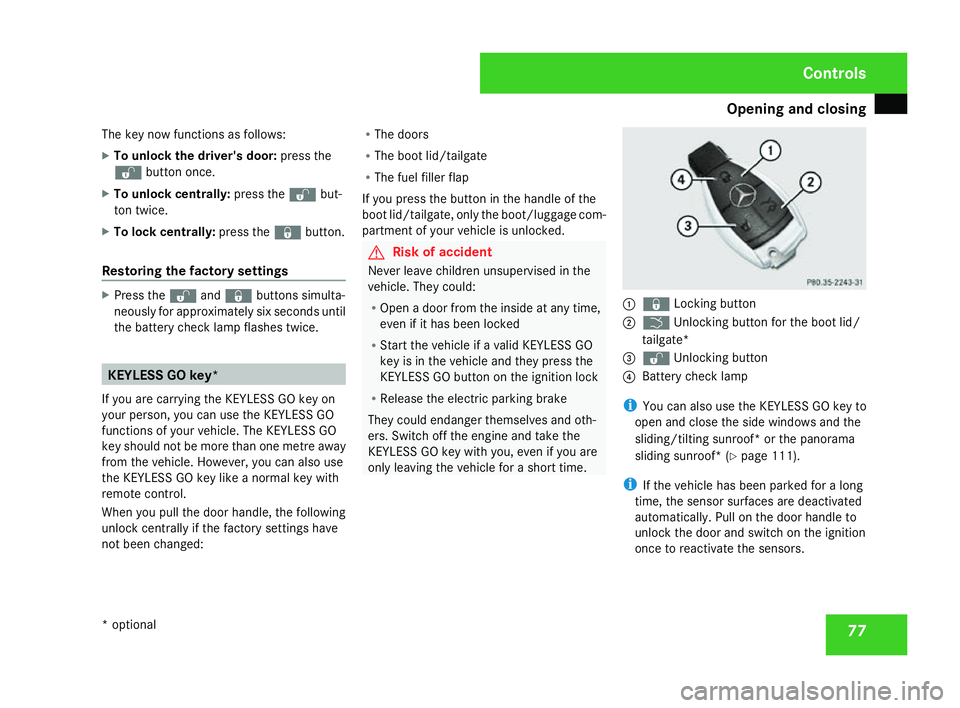
Opening and closing
77
The key now functions as follows:
X
To unlock the driver's door: press the
k button once.
X To unlock centrally :press the kbut-
ton twice.
X To lock centrally :press the jbutton.
Restoring the factory settings X
Press the kandj buttons simulta-
neously for approximately six seconds until
the battery check lamp flashes twice. KEYLESS GO key*
If you are carrying the KEYLESS GO key on
your person, you can use the KEYLESS GO
functions of your vehicle. The KEYLESS GO
key should not be more than one metre away
from the vehicle. However, you can also use
the KEYLESS GO key like a normal key with
remote control.
When you pull the door handle, the following
unlock centrally if the factory settings have
not been changed: R
The doors
R The boot lid/tailgate
R The fuel filler flap
If you press the button in the handle of the
boot lid/tailgate, only the boot/luggage com-
partment of your vehicle is unlocked. G
Risk of accident
Never leave children unsupervised in the
vehicle. They could :
R Open a door from the inside at any time,
even if it has been locked
R Start the vehicle if a valid KEYLESS GO
key is in the vehicle and they press the
KEYLESS GO button on the ignition lock
R Release the electric parking brak e
They could endanger themselves and oth-
ers. Switch off the engine and take the
KEYLESS GO key with you, even if you are
only leaving the vehicle for a short time. 1
j Locking button
2 i Unlocking button for the boot lid/
tailgate*
3 k Unlocking button
4 Battery check lamp
i You can also use the KEYLESS GO key to
open and close the side windows and the
sliding/tilting sunroof* or the panorama
sliding sunroof* (Y page 111).
i If the vehicle has been parked for a long
time, the sensor surfaces are deactivated
automatically. Pull on the door handle to
unlock the door and switch on the ignition
once to reactivate the sensors. Controls
* optional
204_AKB; 2; 3, en-GB
mkalafa
, 2007-06-26T23:11:51+02:00 - Seite 77